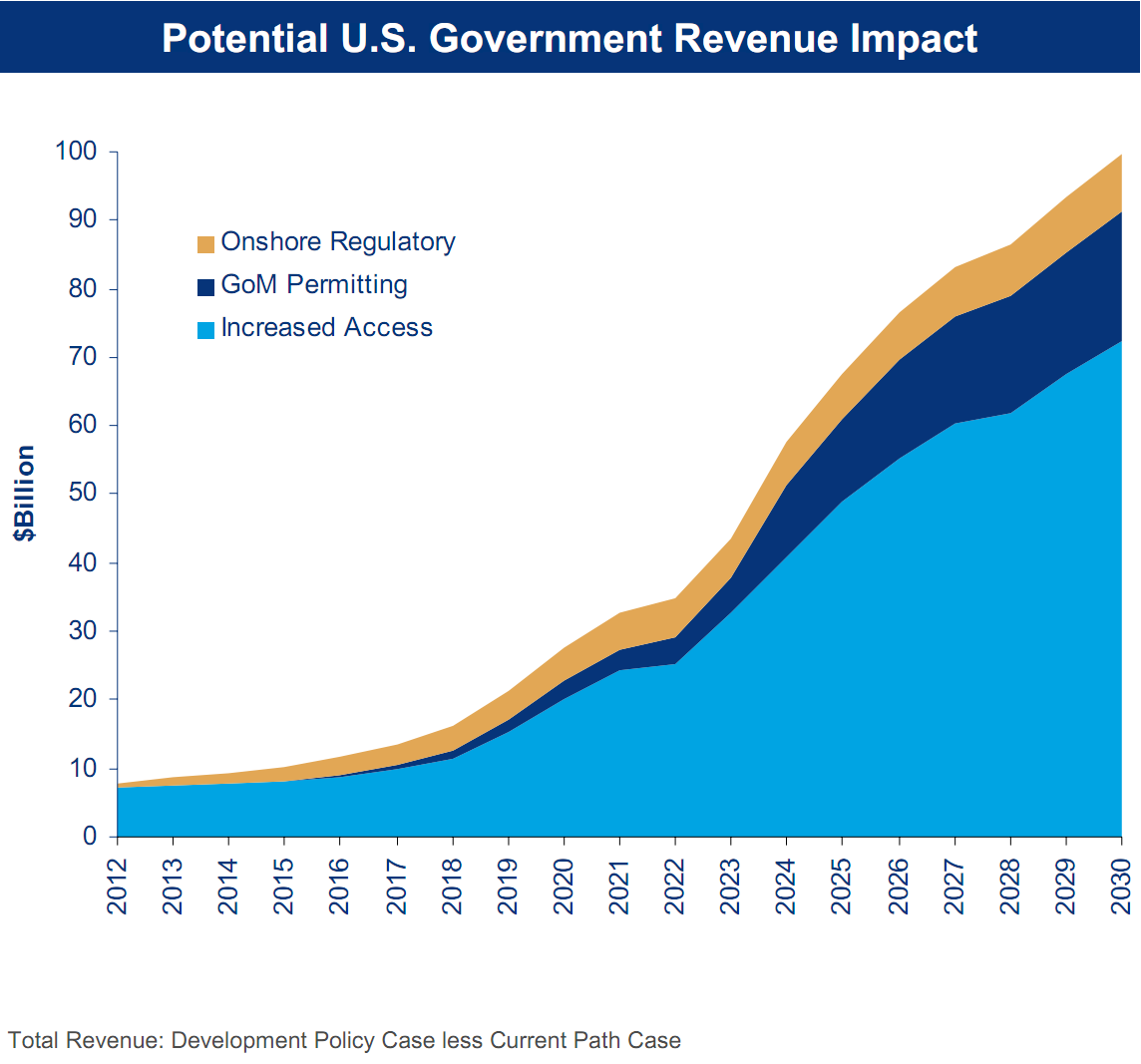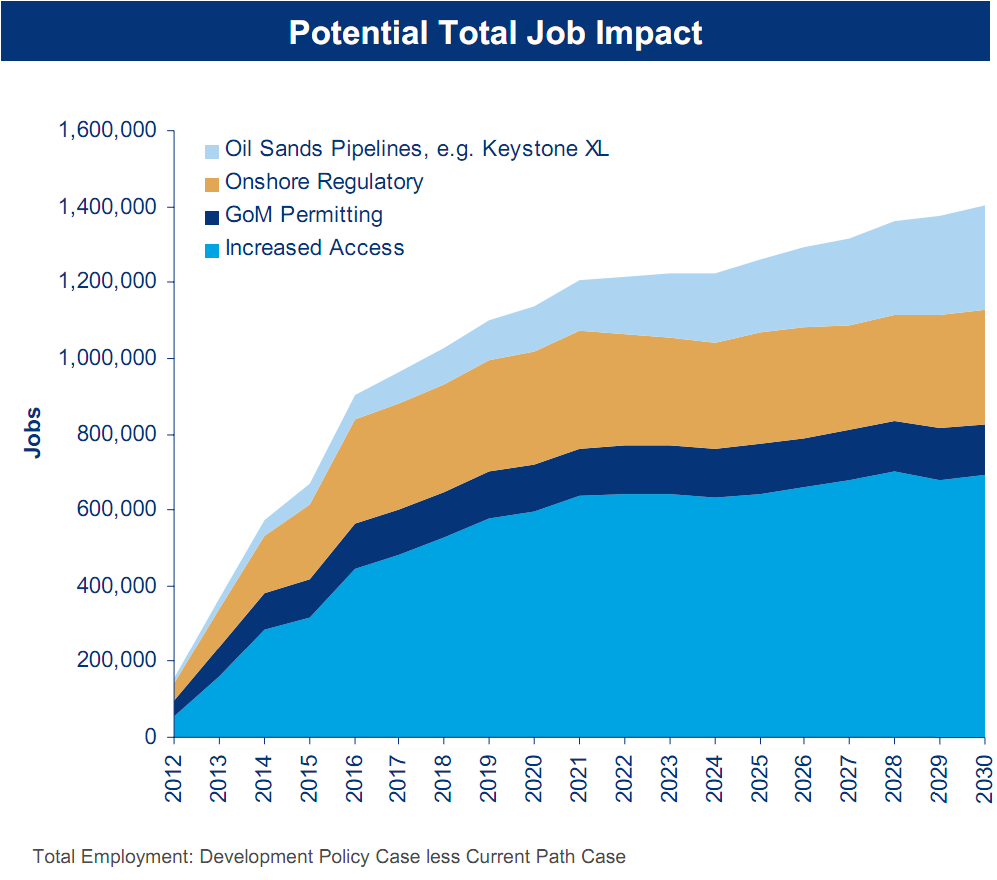By November 23, a team of 12 Congressmen and Senators will determine if they can agree on a way to cut at least $1.2 trillion dollars from the federal deficit. If they fail to agree, predetermined cuts will automatically occur, half of which will be to the Department of Defense budget.[i] One way to get revenues without taxation and spending is to allow the U.S. oil industry to do what countries around the globe are doing: drilling for oil, onshore, offshore, in the Arctic and elsewhere. A recent study by the American Petroleum Institute (API) finds that fewer restrictions on oil drilling could increase government revenues by $800 billion, increase U.S. liquids production by 50 percent, and generate 1.4 million new jobs by 2030.[ii] And, the United States can do that just by allowing the oil industry to develop oil resources here in the United States as other countries are doing in their countries: Canada, Norway, Cuba, Brazil, Russia, Israel, to name just a few.
Oil Finds and Development around the Globe
Brazil. Brazil has some 15 billion barrels of proved oil reserves in its sub-salt offshore fields. They lie in a 2 kilometer deep salt layer under the seabed that is estimated to hold up to 50 billion barrels of oil.[iii] These ultra-deep deposits are drilled at up to three times the normal pressure for offshore oil. By 2020, Petrobras, the country’s government-controlled oil company, is expected to produce 4 million barrels per day, double its volume today.[iv] Other estimates have production as much as 5 million barrels a day and 6.42 million barrel a day by 2020.[v] The sub-salt’s share of total domestic oil production is expected to increase from 2 percent in 2011 to 40.5 percent in 2020.[vi]
While the United States has oil offshore in the Gulf of Mexico and in the Atlantic and Pacific Oceans, the Obama Administration either has that oil off limits to exploration or is slow at approving leases since it lifted the drilling moratorium it put in place after BP’s accident in the Gulf. In Alaska, which has over 50 percent of the entire coastline of the United States[vii], fewer than 100 exploratory wells[viii] have been drilled in federal waters, while over 35,000 wells have been drilled in the Gulf of Mexico[ix]. Alaska has tremendous unknown potential for energy discoveries, but currently, final permits have not been issued to allow exploratory wells. But, during President Obama’s visit to Brazil earlier this year, he pledged that the United States will be a major customer for Brazilian oil.[x]
Canada. Canada is rich in oil sands with 170 billion barrels in reserves. Environmentalists are against oil sands because their production emits more greenhouse gas emissions than the production of conventional oil. Studies have shown that the difference in emissions from well to wheel is only about 15 percent. Further, a new technology, developed by N-Solv, an Alberta Consortium, can extract twice the amount of oil as current methods and reduce greenhouse gas emissions from the process by up to 85 percent.[xi] But none the less, the dispute over the Keystone XL pipeline bringing Canadian oil into the United States is due mainly to the oil sands production issue.
Needless to say, whether the United States buys Canadian oil sands or not, someone will and that someone is most likely China, who has already bought into Canadian oil fields. In July, China’s largest offshore oil producer, Cnooc Ltd. agreed to buy OPTI Canada Inc. for about $2.1 billion a deal that has to be approved by both governments.[xii] Also, whether the United States allows Canada to build the Keystone XL pipeline or not, the United States will be importing Canadian oil sands, moving it by barge, rail, or truck, as we do now. An Ensys Energy & Systems Report, Inc. commissioned by the State Department estimated that rail alone could haul 1.25 million barrels of Canadian crude daily by 2030, nearly twice the amount of the proposed pipeline.[xiii]
Cuba. Cuba has 5 billion to 20 billion barrels of oil off its coast, just 70 miles off the Florida Keys. Soon, Cuban workers on a Chinese-built rig owned by Spain will be drilling in mile deep-waters. China has signed contracts with oil companies from Brazil, India, Italy, Russia and Spain and is in talks with China over lease deals. This oil find could make Cuba independent of Venezuelan crude, from which Cuba gets 60 percent of its oil. Due to our 49-year embargo with Cuba, U.S. oil companies cannot drill in Cuban waters, supply equipment there, or help in the event of an oil spill.[xiv]
Israel. Israel has an estimated 250 billion barrels of recoverable oil shale, second only to that of the United States, which has almost a trillion recoverable barrels. The 250 billion barrels compares favorably to the proven reserves of Saudi Arabia whose reserves total 260 billion barrels. It is estimated that the oil can be recovered at $35 to $40 a barrel using a new technique that does not use water. Israel Energy Initiatives indicates that the process is cleaner than that currently used to produce shale oil because the oil will be separated from the shale rock up to 300 meters beneath the ground, releasing water as a by-product. The extraction process involves heating the rock underground to approximately 325C, the level at which the carbon bonds in the rock start to “crack”. Production on a commercial basis is expected by the end of the decade with production levels beginning at 50,000 barrels per day, which will provide almost 20 percent of Israel’s oil consumption. [xv]
In contrast, the U.S. oil shale resources are mostly on federal lands in Colorado, Utah, and Wyoming, and the U.S. federal government is withholding those lease sales.
Norway. Norway had been seeing oil production declines since 2000 when its oil production peaked due to maturing oil wells. But that trend may be reversed due to two new finds in the North Sea. Statoil ASA has made two offshore finds totaling between 500 million and 1.2 billion barrels, which is among Norway’s top ten discoveries. The new well is less than ten feet from a dry well drilled in 1971.[xvi]
“This shows Norway still has the capacity to deliver world-class discoveries,” Tim Dodson, Statoil’s exploration chief, said. “It’s probably the largest offshore oil discovery anywhere in the world this year. It has given the entire oil industry renewed optimism.”[xvii]
Russia. Russia has opened a portion of its offshore area in the Arctic Ocean to drilling and ExxonMobil has obtained the rights to drill there, but the deal may need to be reviewed by the U.S. government. The United States Geological Survey estimates that the Arctic holds one-fifth of the world’s undiscovered, recoverable oil and natural gas. Russia’s economy is dependent on petroleum for about 60 percent of its export revenue. While Russia currently produces more oil than Saudi Arabia, its Siberian onshore oil fields are in decline, so the country needs to develop new areas.
This contrasts with the U. S. stance regarding drilling offshore Alaska where environmental restrictions and lawsuits by conservation organizations have held off exploration.[xviii]
The API Study
What could the oil industry achieve if restrictions on oil drilling in the United States were lessened? The American Petroleum Industry commissioned a study that assumed oil drilling would be allowed off the currently prohibited areas of the East and West Coasts, in waters off Florida’s Gulf Coast, in Alaska’s Arctic National Wildlife Refuge, and on most federal public land that is not a national park. It also assumed that it would get approval to build pipelines to accommodate a doubling of Canadian oil sands production and the continuation of the tax policies currently in place for the oil industry.[xix]
The API commissioned the study from energy consultants Wood Mackenzie, who found that domestic production of petroleum liquids would increase from 7.8 million barrels per day in 2010 to 9 million barrels per day in 2030 under current policies due to increased production from shale oil and deepwater drilling. However, if the industry could meet the assumptions of the study, domestic liquids production could reach 15.4 million barrels per day close to the 19 million barrels a day that we currently consume. That would create 1 million new jobs over the next seven years and 1.4 million by 2030. The industry already supports more than 9 million jobs throughout the economy. The study indicates that the United States can come close to producing enough new oil and natural gas to displace all non-North American imports within 15 years. More than $800 billion in cumulative new government revenue could be generated by 2030 and $127 billion by 2020 – equal to about two and a half years’ worth of current federal spending on roads. Most importantly, no new taxes or increased government spending is needed to accomplish the results of the study.[xx]
Conclusion
Around the globe, countries are drilling for oil onshore, offshore, and in oil shale deposits. But the United States is hampered by government rules and restrictions to developing its vast resources. Without increasing taxes and without increasing government spending, the oil industry in the United States could make us independent of non-North American oil imports. And in doing so, they could create jobs and add billions of dollars to government revenues. Why don’t we take the challenge?
[i] Houston Chronicle, Republican says Arctic drilling can help cut deficit, September 7, 2011, http://www.chron.com/business/energy/article/Republican-says-Arctic-drilling-can-help-cut-2160023.php
[ii] CNN Money, Big Oil: To create jobs, let us drill more, September 7, 2011, http://money.cnn.com/2011/09/07/news/economy/oil_jobs
[iii] Petrobas chief bullish on Brazil oil output, August 1, 2011, http://www.ft.com/intl/cms/s/0/0db3473c-bc59-11e0-acb6-00144feabdc0.html#axzz1XOgKrBf1
[iv] The Economist, Brazil’s offshore oil: In deep waters, February 3, 2011, http://www.economist.com/node/18065645
[v] The Wall Street Journal, Brazil Torn Over New Oil Riches, July 22, 2011, http://professional.wsj.com/article/SB10001424053111904233404576460273986667728.html?mg=reno-wsj and Petrobas chief bullish on Brazil oil output, August 1, 2011, http://www.ft.com/intl/cms/s/0/0db3473c-bc59-11e0-acb6-00144feabdc0.html#axzz1XOgKrBf1
[vi] Petrobas chief bullish on Brazil oil output, August 1, 2011, http://www.ft.com/intl/cms/s/0/0db3473c-bc59-11e0-acb6-00144feabdc0.html#axzz1XOgKrBf1
[viii] Department of the Interior , http://www.alaska.boemre.gov/fo/wellhistory/wellsbyRegion.pdf
[ix] Department of the Interior, http://www.gomr.boemre.gov/homepg/whatsnew/speeches/manuscr1og.pdf
[x] The Telegraph, Obama says US to be a major purchaser of Brazilian oil, March 19, 2011, http://www.telegraph.co.uk/finance/newsbysector/energy/oilandgas/8393292/Obama-says-US-to-be-major-purchaser-of-Brazilian-oil.html
[xi] Technology Review, New Process Could Make Canadian Oil Cheaper, Cleaner, August 3, 2011, http://www.technologyreview.com/energy/38204/?p1=A1
[xii] The Wall Street Journal, Cnooc Sets Canadian Deal, July 29, 2011, http://professional.wsj.com/article/SB10001424052702303795304576457121216529368.html?mg=reno-wsj
[xiii] Forbes, Study: Tar sands oil will reach US sans pipeline, September 7, 2011, http://www.forbes.com/feeds/ap/2011/09/07/general-energy-nd-oil-pipeline-rail_8663353.html
[xiv] The National Journal, Drill, Bebe, Drill, July 28, 2011, http://nationaljournal.com/magazine/will-sloppy-drilling-off-the-coast-of-cuba-threaten-florida-gulf-beaches–20110728
[xv] The Australian, Oil shale reserves can turn Israel into a major world producer, March 21, 2011, http://www.theaustralian.com.au/business-old/mining-energy/oil-shale-reserves-can-turn-israel-into-major-world-producer/story-e6frg9ef-1226025327281
[xvi] Bloomberg, Norway Sees Longer Oil Era as North Sea Find Offers Hidden Giant, August 17, 2011, http://www.bloomberg.com/news/2011-08-16/norway-sees-longer-oil-era-as-north-sea-find-offers-hidden-giant.html
[xvii] Ibid.
[xviii] The New York Times, Exxon Reaches Arctic Oil Deal With Russians, August 30, 2011, http://www.nytimes.com/2011/08/31/business/global/exxon-and-rosneft-partner-in-russian-oil-deal.html?pagewanted=2&_r=1
[xix] CNN Money, Big Oil: To create jobs, let us drill more, September 7, 2011, http://money.cnn.com/2011/09/07/news/economy/oil_jobs
[xx] Wood Mackenzie energy consulting, U.S. Supply Forecast and Potential Jobs and Economic Impacts (2012-2030), September 7, 2011, http://www.api.org/Newsroom/upload/API-US_Supply_Economic_Forecast.pdf





